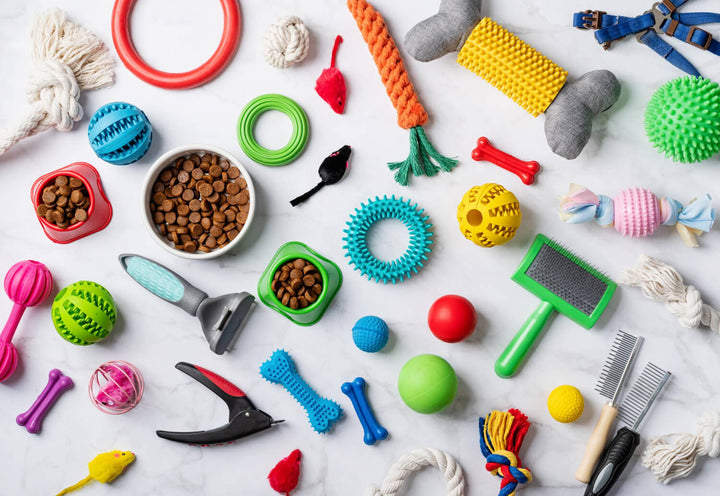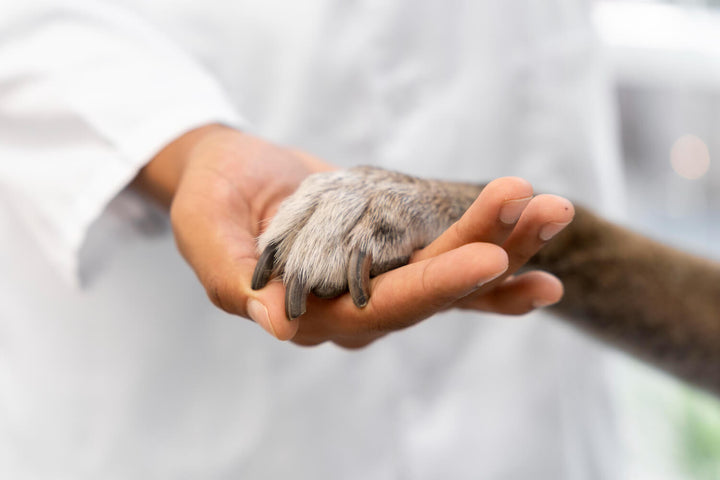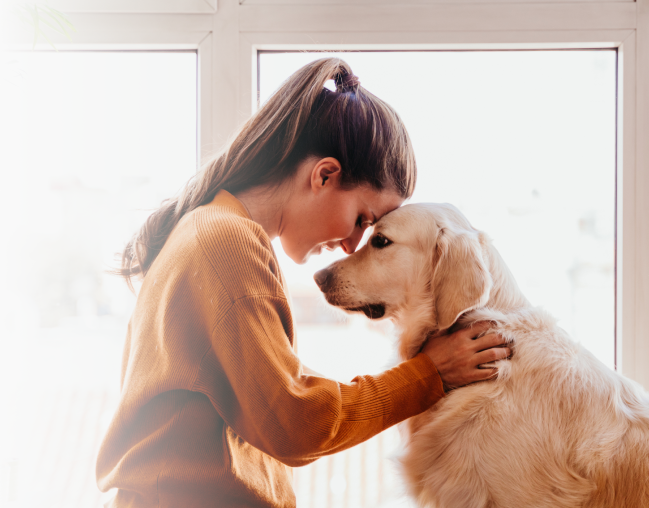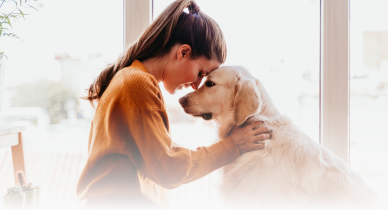Enter the world of the Bloodhound, a breed that combines remarkable scent-tracking skills with a gentle and affectionate nature. Known for their unparalleled ability to follow a scent trail for miles, Bloodhounds are not just dogs, but canine detectives who excel in search and rescue missions. Their unique appearance and exceptional olfactory powers make them a fascinating and valuable member of the canine world.
Did You Know these Facts about the Bloodhound?
-
Bloodhounds possess a sense of smell that is second to none among all dog breeds. Their nose has nearly 300 million scent receptors, enabling them to track even the faintest scent trail.
-
With origins dating back to ancient Egypt, Bloodhounds are one of the oldest known breeds. Their ancestors were used for hunting large game and have evolved into the scent experts we know today.
-
Known for their long, droopy ears, Bloodhounds' ears help funnel scents towards their nose while they're on the trail. Their ears are an essential tool in their scent-tracking abilities.
-
Despite their imposing size, Bloodhounds have a gentle and friendly demeanor. They are known for their affectionate nature and get along well with families and other pets.
- Bloodhounds have played pivotal roles in solving numerous criminal cases and locating missing persons. Their remarkable tracking skills have earned them a respected place in search and rescue teams worldwide.
When compared to all other formally registered breeds, Bloodhounds are considered a moderately popular breed ranking at #50 according to the American Kennel Club. Their specialized skills make them highly sought after for search and rescue operations, but they may not be as commonly seen as some other breeds.

Traits of the Bloodhound Breed
Overall Personality. Bloodhounds are renowned for their unique blend of qualities that make them stand out in the canine world. With their affectionate, patient, and deeply devoted nature, these dogs form strong bonds with their families. Their calm and easygoing demeanor is like a soothing presence, making them ideal companions for various households.
Family Life. Bloodhounds thrive when they are considered an integral part of the family unit. Their innate friendliness and exceptional patience with children highlight their suitability for homes with kids. These gentle giants understand the dynamics of family life and enjoy being involved in every aspect of it.
Physical Appearance. The Bloodhound's physical appearance is unmistakable, featuring distinct characteristics that set them apart. Their iconic long ears serve a practical purpose, funneling scents towards their remarkable noses. The loose skin that hangs from their frame contributes to their unique appearance and helps trap scents as they follow trails. A wrinkled face adds to their charm, while their coat comes in striking colors like black and tan, liver and tan, and red. Their large and powerful build showcases their historical role as scent-tracking dogs, emphasizing their prowess in search and rescue operations.
Sociability. Bloodhounds are known for their sociable nature and the ease with which they forge relationships with other dogs. Early socialization plays a crucial role in shaping their interactions positively. Whether at the dog park or a family gathering, Bloodhounds tend to exude friendliness and are often drawn to both humans and other pets.
Average Sizes & Life Expectancy
- Height: 23 to 27 inches tall (58 to 68 cm)
- Weight: 80 to 110 pounds (36 to 50 kg)
- Life Expectancy: Around 10 to 12 years
Detailed Description of the Bloodhound Breed
Physical Appearance. The Bloodhound's appearance is captivating, characterized by distinctive features that make them easily recognizable. With their long, droopy ears that sweep the ground, their wrinkled forehead, and soulful eyes, Bloodhounds exude an air of gentle curiosity. Their loose skin and substantial jowls give them a unique charm, while their powerful frame showcases their historical role as tracking dogs. These large dogs stand tall with an imposing presence, showcasing their strength and endurance.
Notable Traits. The Bloodhound is renowned for its impeccable sense of smell, which is considered one of the most powerful among all dog breeds. Their olfactory abilities have earned them a reputation as expert scent trackers, making them invaluable in search and rescue operations. Their velvety ears are not just endearing but also serve a practical purpose, channeling scents towards their remarkable noses.
Temperament and Personality. Bloodhounds possess an endearing temperament that endears them to families and individuals alike. Their affectionate and patient nature makes them exceptional companions, well-suited for households with children. These dogs are laid-back and calm, seemingly unaffected by the chaos of the world around them. Their gentle demeanor extends to other pets as well, and they tend to get along well with other dogs and even cats when introduced at an early age.
Adaptability. Bloodhounds are adaptable dogs that can thrive in a variety of environments. While they may have a penchant for tracking scents, they also enjoy the comforts of home life. Due to their size, they may not be the best fit for small apartments, as they appreciate having room to move around. Regular exercise and mental stimulation are essential to keep their minds and bodies engaged.
Care Guidelines. Grooming the Bloodhound is relatively simple. Their short coat requires regular brushing to keep it clean and healthy. As with any breed, attention should be paid to their ears to prevent moisture buildup and potential infections. Due to their droopy eyes, they might be prone to tear stains, which can be managed with proper cleaning. Additionally, regular nail trimming and dental care are important aspects of their overall health maintenance.
Training Strategies. Bloodhounds are intelligent dogs, although they may occasionally exhibit a stubborn streak. Positive reinforcement training methods work best for them, as they respond well to treats and praise. Early socialization is crucial to help them develop good manners and learn to interact positively with other dogs and people. Training should be consistent and patient, taking into account their unique scent-tracking tendencies.
Notable in History and Pop Culture. Bloodhounds have a storied history dating back centuries. Their keen sense of smell has been used for various purposes, from tracking game for hunters to assisting in law enforcement activities. They played an important role in tracking during times of war and have been instrumental in finding missing persons.
In pop culture, Bloodhounds have made appearances in movies, TV shows, and literature, often portrayed as the quintessential scent-tracking dog.
In conclusion, if you're considering bringing a Bloodhound into your life, be prepared to embrace their affectionate and patient nature. They thrive in environments where they can be part of the family and enjoy regular outdoor activities. Their remarkable scent-tracking abilities and calm demeanor make them not only wonderful companions but also valuable members of search and rescue teams. With proper care, training, and socialization, a Bloodhound can become a loyal and devoted companion for years to come.
What to expect when living with the Bloodhound Breed
Personality. Owning a Bloodhound can be a truly rewarding experience, but it's important to be prepared for the unique characteristics and needs of this breed. Their gentle and patient personality makes them wonderful companions, especially for families with children. Bloodhounds thrive in environments where they are considered part of the family, enjoying plenty of interaction and attention from their human companions. These scent-tracking experts have an incredible sense of smell that drives their curiosity and desire to explore. As a result, they require ample mental and physical stimulation to keep them engaged and prevent boredom. Long walks, scent games, and outdoor activities are all great ways to provide the enrichment they need.
Ideal Environment. Bloodhounds are well-suited for both urban and rural settings, as long as they have access to outdoor spaces where they can explore and follow their noses. While they have a laid-back nature, they do need regular exercise to maintain a healthy weight and prevent boredom-related behaviors.
Maintenance Level. In terms of maintenance, Bloodhounds have specific care needs that prospective owners should be aware of. Their droopy ears can be prone to infections, so regular cleaning and drying are necessary. Their wrinkles should also be kept clean and dry to prevent skin issues. Additionally, their nails should be trimmed regularly, and dental care is important to maintain their overall health.
Overall Health Expectations and best Health Tests for the Bloodhound Breed
Health Considerations. Bloodhounds are generally healthy dogs, but like all breeds, they can be prone to certain genetic health issues. Some of the conditions to watch out for include hip dysplasia, elbow dysplasia, bloat (gastric torsion), and eye issues such as entropion and ectropion. Regular visits to the veterinarian and preventive health care are crucial to catch any potential health problems early.
Recommended Health Tests. For prospective Bloodhound owners, it's important to work with a reputable breeder who conducts health testing on their breeding dogs to minimize the risk of passing on genetic health issues. Health tests may include hip and elbow evaluations, ophthalmologic examinations, and genetic tests for specific conditions.
Best Nutrition, Diet & Supplements for the Bloodhound Breed
Nutrition and Diet. Bloodhounds are large and active dogs that require a balanced and nutritious diet to support their energy needs and overall health. Choose a high-quality commercial dog food that is appropriate for your Bloodhound's age, size, and activity level. Look for a formula that lists a meat source as the main ingredient. Consider feeding your Bloodhound a diet that includes real meat, whole grains, vegetables, and fruits. A diet rich in protein will help support their muscle development and energy levels. Lastly, divide your dog's daily food portion into two or three meals to prevent overeating and aid in digestion.
Hydration is Key. Ensure your Bloodhound always has access to fresh, clean water. Proper hydration is vital for digestion, temperature regulation, and overall vitality.
Supplements. While a well-balanced diet should provide most of the necessary nutrients, there are some supplements that can benefit Bloodhounds. Consult your veterinarian before adding any supplements to your dog's diet. Omega-3 fatty acids are beneficial for maintaining healthy skin and coat, as well as supporting joint health. Fish oil supplements can be added to their diet. Glucosamine and chondroitin can help support joint health and prevent issues like hip dysplasia, which Bloodhounds can be prone to. Probiotics can aid in digestion and promote a healthy gut, which is important for overall well-being.
Foods to Avoid. Bloodhounds have sensitive stomachs, so it's important to avoid feeding them foods that can lead to digestive upset. Avoid feeding them human foods that are toxic to dogs, such as chocolate, grapes, raisins, onions, garlic, and artificial sweeteners. Be cautious with fatty and high-calorie foods, as Bloodhounds can be prone to obesity. Obesity can exacerbate joint issues and other health problems.
Grooming Requirements for the Bloodhound Breed
Coat Maintenance and Shedding. Bloodhounds have a short coat that sheds moderately throughout the year. Regular brushing with a bristle brush or rubber curry comb can help remove loose hair and keep their coat healthy.
Paw Care and Hygiene. Bloodhounds are active dogs, and their paws can be prone to cuts and abrasions. Regularly inspect their paw pads for any signs of injury or irritation. Trim their nails regularly to prevent overgrowth, as long nails can lead to discomfort and difficulty walking.
Ear Care. Bloodhounds are known for their long, droopy ears that can trap dirt and moisture, making them prone to infections. Check their ears regularly for signs of redness, odor, or discharge. Clean their ears with a veterinarian-approved ear cleaner and cotton ball. Be gentle and avoid inserting anything into the ear canal.
Bathing Frequency. Bathing should be done as needed, typically every 6-8 weeks or when they become dirty or smelly. Use a mild dog shampoo to avoid stripping their coat of natural oils.
Exercise Required for the Bloodhound Breed
Scent Work: Bloodhounds excel at scent tracking. Engaging them in scent-related games and activities can provide mental stimulation and satisfy their natural instincts. Regular walks on a leash are important to keep them fit and healthy. Bloodhounds have a tendency to follow their nose, so it's important to keep them on a secure leash during walks.
Bloodhounds benefit from at least 60-90 minutes of moderate exercise each day. This can include a combination of walks, playtime, and mental stimulation. While they enjoy outdoor activities, they are sensitive to extreme weather conditions. Avoid excessive exercise during hot or cold weather to prevent overheating or discomfort.
Bloodhounds are intelligent dogs that require mental challenges to prevent boredom. Engage them in puzzle toys, interactive games, and training sessions to keep their minds active. Bloodhounds enjoy interactive play with their owners, such as fetch or tug-of-war. They also enjoy spending time exploring new environments and sniffing around.
It's important to work on recall training and keep them on a leash or in a securely fenced area during outdoor activities. Overall, while Bloodhounds may not be the most high-energy breed, they do require regular physical and mental stimulation to lead a happy and healthy life.
Training Tips for the Bloodhound Breed
Training a Bloodhound requires patience, positive reinforcement, and understanding of their unique personality traits.
Do…
- Begin training and socialization from a young age to shape their behavior and interactions positively.
- Use positive reinforcement techniques, such as treats, praise, and rewards, to motivate your Bloodhound during training sessions.
- Keep training sessions short and engaging to prevent boredom.
- Be patient and allow them time to process commands and respond.
- Leverage their exceptional sense of smell in training. Incorporate scent-related games and exercises to keep them engaged.
- Use consistent commands and cues to avoid confusion. Repetition helps them learn and understand what is expected of them.
- Expose your Bloodhound to various people, places, and situations to build their confidence and ensure they are well-adjusted.
- Keep training sessions interesting by introducing new challenges and activities. This prevents boredom and keeps them focused.
Don't…
- Bloodhounds are sensitive dogs that respond poorly to harsh training methods. Avoid yelling, physical punishment, or intimidating tactics.
- Give too much information in one session as this can can overwhelm them. Break down training tasks into manageable steps.
- Get impatient or frustrated. Bloodhounds may take their time to understand and execute commands.
- Repeat commands without results - this can lead to them ignoring commands. If they don't respond, reassess and adjust your training approach.
- Neglect socialization. Bloodhounds are social dogs, so this can lead to shyness or behavioral issues. Expose them to new experiences gradually.
- Practice off-leash in unsecured areas. Bloodhounds have a strong scent drive and can follow their nose, often ignoring commands.
- Reward unwanted behaviors with attention. Redirect their focus to positive behaviors instead.
- A bored Bloodhound can become stubborn. Keep their minds engaged through training, games, and mental stimulation.
The Bloodhound Breed is Suitable For
Bloodhounds are well-suited for homes that can provide them with ample space and a patient and understanding environment. These dogs enjoy the company of active families who can provide them with regular exercise and mental stimulation.
A home with a secure and spacious yard gives Bloodhounds the opportunity to explore and follow scents. However, supervision is necessary to prevent them from wandering off. Bloodhounds are patient and gentle with older children who understand how to interact with dogs respectfully. Their size can sometimes unintentionally knock over smaller children.
Bloodhounds excel in scent-related activities like tracking and search and rescue. Homes that enjoy participating in dog sports and activities will provide an outlet for their exceptional scenting abilities. Bloodhounds often thrive in rural or suburban settings where they can explore nature and enjoy a quieter environment.
The Bloodhound Breed is Not Suitable For
Bloodhounds' large size and need for space make apartment living challenging. They require ample room to move around comfortably. Due to their strong scent drive, Bloodhounds may not get along well with smaller pets like rabbits or hamsters. Early socialization can help mitigate this tendency.
Bloodhounds require experienced owners who understand their unique needs and training requirements. Novice dog owners may find their independent nature challenging to manage.
They are also known shedders, and their loose skin folds can also lead to skin issues. Households with severe allergies may find their shedding problematic.
Bloodhounds thrive on human interaction and can become anxious or destructive if left alone for extended periods. They require constant companionship and mental stimulation to thrive.
Famous Bloodhound Owners
-
Sherlock Holmes - In Sir Arthur Conan Doyle's Sherlock Holmes series, the fictional detective Sherlock Holmes had a Bloodhound named "Toby" who often aided in his investigations by following scents.
-
Duke of Clarence - King Richard III's brother, George Plantagenet, Duke of Clarence, was known to own Bloodhounds. Bloodhounds' tracking abilities were often utilized in medieval times for hunting and tracking criminals.
- Medieval Royalty - Bloodhounds were favored by medieval European nobility for their scenting abilities. They played a role in hunting and tracking game.
Accomplishments of the Bloodhound Breed
Bloodhounds have excelled in search and rescue operations due to their exceptional scenting abilities. They have helped locate missing persons and disaster survivors.
They are often employed by law enforcement agencies for tracking and locating suspects and missing individuals.
Bloodhounds have made appearances in various movies, TV shows, and literature, portraying their tracking skills. They are often depicted as the archetypal scent-tracking dog.
While not known for breaking world records, Bloodhounds have a historic and consistent record of aiding humans in search and rescue missions and law enforcement activities.
The History of the Bloodhound Breed
The Bloodhound, with its legendary scent-tracking abilities, has a history that dates back centuries. Its origins can be traced to ancient times, where it evolved through a process of selective breeding for specific purposes.
Creation and Purpose. The Bloodhound's lineage is believed to have originated in ancient Egypt and was further developed by monks in European monasteries during the Middle Ages. Bred for their exceptional olfactory senses, they were initially known as "St. Hubert Hounds" after the patron saint of hunters. These hounds were developed to assist in tracking game and locating wounded animals during hunts.
With their superior scenting abilities, Bloodhounds were soon recognized for their potential in tracking humans as well. They were employed in Europe to track criminals and fugitives, earning them the nickname "Sleuth Hound." Their name "Bloodhound" likely comes from the term "blooded hound," referring to their noble lineage and high-quality breeding.
Early Roles and Evolution. Over time, the Bloodhound's distinctive traits were refined through careful breeding to enhance their scent-tracking abilities. Their long ears and loose skin were developed to help trap and funnel scents toward their highly sensitive noses. Their wrinkled faces may have evolved to catch and hold scent particles as well.
During the medieval period, Bloodhounds were highly esteemed and were often given as valuable gifts between nobles and royalty. Their legendary tracking skills and noble appearance earned them a prominent place in the courts and hunting parties of European monarchs.
Changes and Modern Impact. In modern times, the Bloodhound's role has expanded beyond hunting and tracking to include search and rescue operations and law enforcement. Their remarkable ability to track scents over great distances has been invaluable in locating missing persons and suspects. They have been instrumental in numerous high-profile cases, showcasing their enduring relevance and adaptability.
Throughout history, the Bloodhound's distinct characteristics have been preserved through careful breeding. While they are no longer as widely used in hunting, their remarkable scent-tracking abilities continue to be honed and appreciated.
Despite their changes in roles, the Bloodhound's core traits remain steadfast – their exceptional olfactory senses, gentle nature, and loyalty to humans. Their legacy as a scent-tracking legend lives on, and they are celebrated for their historical significance, whether it's in the world of law enforcement, search and rescue, or the hearts of devoted dog enthusiasts.
The Bloodhound Breed Standard
The Bloodhound is a remarkable breed known for its exceptional scent-tracking abilities. According to the American Kennel Club (AKC), the Bloodhound falls under the Hound Group. This group encompasses breeds that are bred and trained for hunting and tracking, making the Bloodhound a natural fit due to its unparalleled sense of smell.
The American Kennel Club's formal Breed Standard outlines the ideal characteristics of a Bloodhound. This breed is well-known for its large and imposing build, with a loose and wrinkled skin that adds to its distinctive appearance. Its coat comes in various colors, such as black and tan, liver and tan, and red, all of which contribute to its striking look. Bloodhounds are revered for their deep, soulful eyes and long, drooping ears. The standard serves as a benchmark for evaluating Bloodhounds in conformation shows, ensuring that they adhere to the breed's unique characteristics.
The Bloodhound Club, Inc. is the national breed club dedicated to the welfare and advancement of Bloodhounds. You can find more information about this noble breed, their activities, and resources on their official website: The Bloodhound Club, Inc..
General Appearance
Head, Muzzle, Nose. The Bloodhound's head is one of its most distinctive features, showcasing an impressive combination of size and character. The skull is well-proportioned, slightly domed, and adorned with deep wrinkles, especially around the forehead. The well-defined skull adds to the head's prominence, while the skin forms loose folds that contribute to the breed's unique appearance.
The Bloodhound boasts a long and powerful muzzle, ideal for capturing scents effectively. The nose is exceptionally large, featuring wide-open nostrils designed to capture and channel scents to its highly developed olfactory system. This breed's olfactory capabilities are among the most advanced in the dog kingdom.
Teeth. The Bloodhound's teeth are strong and well-aligned, with a scissor bite that allows efficient chewing. Their teeth play a crucial role in their tracking work, helping them navigate various terrains with ease.
Neck. The breed's neck is muscular, powerful, and slightly arched. This robust neck enables the Bloodhound to carry its head low when tracking scents on the ground, a stance that allows them to capture scents more effectively.
Body. The Bloodhound's body is both powerful and balanced. Its broad and deep chest houses well-sprung ribs that provide ample lung capacity, contributing to its exceptional endurance. The back is strong and level, while the loin is muscular and taut, allowing for flexibility and agility.
Tail. The tail of the Bloodhound is long, tapering, and slightly curved. It is set high and carried well above the body, accentuating the breed's elegant posture and balanced proportions.
Coat. The Bloodhound's short and dense coat lies close to the body, offering protection against the elements while not hindering its movement. The coat comes in various colors, including black and tan, liver and tan, and red. These color combinations further contribute to the breed's striking appearance.
Size. Bloodhounds are large dogs with impressive stature. In terms of size, males typically stand around 25 to 27 inches (63.5 to 68.5 cm) at the shoulder, while females are slightly smaller, measuring around 23 to 25 inches (58.5 to 63.5 cm). In terms of weight, males weigh between 90 to 110 pounds (41 to 50 kg), and females weigh around 80 to 100 pounds (36 to 45 kg).
Gait. The Bloodhound's gait is both impressive and effortless, showcasing its agility and strength. When in motion, the breed moves with a fluid and balanced stride, covering the ground smoothly and efficiently. Their powerful hindquarters and well-muscled legs contribute to their confident and purposeful movement.
In summary, the Bloodhound's general appearance exudes power, elegance, and purpose. From their distinctive head and remarkable olfactory capabilities to their balanced body and graceful gait, every aspect of their physical attributes serves as a testament to their exceptional tracking abilities and unwavering dedication to their work.
Reputable Breeders
For those seeking a well-bred Bloodhound, there are reputable breeders who prioritize health, temperament, and the breed's standard. Here are a few notable breeders:
Top Shelters for Adoption
Adopting a dog can be a rewarding experience. Here are five shelters where you might find a Bloodhound in need of a loving home:
Top 5 Frequently Asked Questions & Answers about the Bloodhound Breed
Are Bloodhounds good family dogs?
Bloodhounds are gentle giants and can make excellent family companions, but their large size requires proper supervision around children.
Do Bloodhounds shed a lot?
Yes, Bloodhounds do shed, but regular grooming can help manage their shedding.
Are Bloodhounds easy to train?
While intelligent, Bloodhounds can be stubborn due to their strong scent instincts. Patient, consistent training methods work best.
How much exercise do Bloodhounds need?
Bloodhounds require regular exercise to keep them physically and mentally stimulated. Daily walks and playtime are essential.
What are common health concerns for Bloodhounds?
Bloodhounds are prone to certain health issues, including hip and elbow dysplasia and ear infections.
A Final Tip for Bringing a Bloodhound into Your Life
Embrace the spirit of adventure and loyalty that comes with welcoming a Bloodhound into your home. Their remarkable tracking abilities, gentle demeanor, and unwavering loyalty make them an exceptional addition to families and individuals alike. Be prepared for a devoted companion who loves outdoor activities and thrives on human interaction. The bond you forge with your Bloodhound will be one of loyalty, trust, and boundless love, creating cherished memories and a strong connection that will last a lifetime.
Valuable Resources for Your Journey to Parenting a Bloodhound
At Felicitails you will find many wonderful services, supplies and guides for your life ahead with a loving pup at your side.

Hope You Enjoyed The Read!
Tag Cloud

A warm welcome from Lindsay & Huck (my English Pointer). Hope you enjoy the read and find just what you are looking for when it comes to living your best life with your loved pets.

-
Dog Breeds
(42)
-
Emotional Support Animals
(10)
-
Dog Grooming
(6)
-
Dog Health
(18)
-
Life with a Dog
(18)
-
Dog Nutrition
(11)
-
Service Animals
(11)
-
Dog Training
(5)







